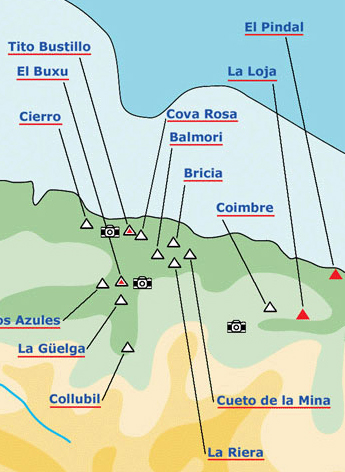Photo Archives: Paleolithic Art in Northern Spain
El Buxu
Preview Edition
- 22 photos(about1280x1000,1470x980/JPEG) and the 1 variation(about1280x1000/JPEG).
- Commentary by César González Sainz & Roberto Cacho Toca, Univ. of Cantabria.
- Royality Free for private and educational use.
In this downloadable photo archives are contained 22 photos and the 1 variation of Paleolithic cave art of El Buxu cave with the archeological data and commentary as shown in this preview pages. Only the small sized reference images and a part of commentary are shown in this preview edition, but if you are interested to see more and to use these photos, please go to Kagi store and purchase the data package. Once payment has been made at the Kagi store, you will receive an e-mail containing the URL to download the data package. All photos that are contained in this package are ROYALITY FREE for private and educational use.
 El Buxu Cave
El Buxu Cave
This cave is situated in a limestone outcrop, in a small valley occupied by the Entrepeñs stream. This is a tributary of the River Güeña, which in turn flows into the River Sella at Cangas de Onis, a town a few kilometers away from Cueva del Buxu.
The cave was discovered by chance in December 1916 by one Cesáreo Cardin, an habitual collaborator in the archaeological digs of Hugo Obermaier and Conde de la Vega del Sella. These had asked him to visit Cueva de Las Inxanas, located in the same hill as Cueva de Buxu. C. Cardin, mistaking El Buxu for that cave, entered and found its examples of parietal art. He immediately informed Obermaier and Vega del Sella of his discovery, and they began the study of its contents, publishing their results two years later.
The cave has been modified drastically since then, mainly due to the work carried out to accommodate tourist visits. These changes not only substantially altered the aspect of the cave but also destroyed much of the its archaeological deposit.
The entrance is formed by an outer vestibule six meters wide and five meters deep, facing south-west. The original rock-shelter, however, was much larger, as is shown by the presence of numerous blocks of limestone which have collapsed from the roof, and the remains of a former floor, partially eroded away. This former rock-shelter would have faced south, situated 300 meters above present-day sea level, and 25 meters above the valley floor. Most of the archaeological deposit must have been in this outer area, and as we have mentioned it was practically destroyed by the work carried out in the cave in the 1950s.
---------------------------
[References]
Menéndez, M. 1984: La cueva del Buxu. El arte parietal. Boletin del Instituto de Estudios Asturianos, 112: 755-801
Obermaier, H., Vega del Sella, C. de la, 1918: La cueva del Buxu. CIPP, Memoria no. 20. Madrid.
|
Photographed by Takeo Fukazawa & Co-Project Team of Texnai Inc. and the University of Cantabria
Commentary by César González Sainz & Roberto Cacho Toca, Univ. of Cantabria
Texnai Inc.:
2-1, Udagawa-cho, Shibuya-ku, Tokyo, Japan. Tel:03-3464-6927 Fax:03-3476-2372
e-mail:info@texnai.co.jp
Copyright reserved by Takeo Fukazawa &Texnai, Inc., University of Cantabria, IPA
|
|